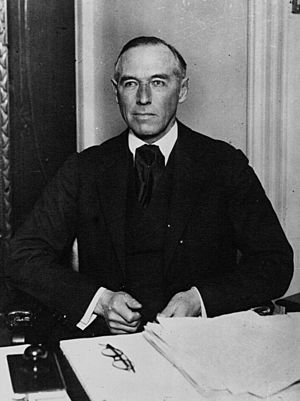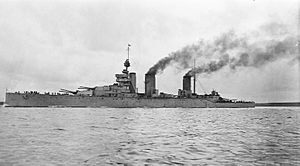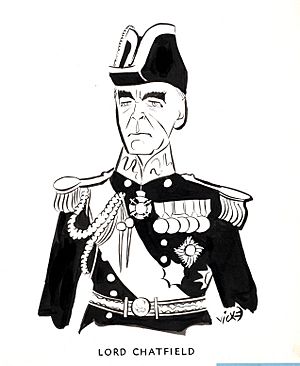Ernle Chatfield, 1st Baron Chatfield facts for kids
Quick facts for kids
Admiral of the Fleet The Right Honourable
The Lord Chatfield
|
|
|---|---|

Admiral of the Fleet Sir Ernle Chatfield
|
|
| Minister for Coordination of Defence | |
| In office 29 January 1939 – 10 May 1940 |
|
| Prime Minister | Neville Chamberlain |
| Preceded by | Sir Thomas Inskip |
| Succeeded by | Winston Churchill as Minister of Defence |
| Personal details | |
| Born | 27 September 1873 Southsea, Hampshire |
| Died | 15 November 1967 (aged 94) Farnham Common, Buckinghamshire |
| Military service | |
| Allegiance | United Kingdom |
| Branch/service | Royal Navy |
| Years of service | 1886–1938 |
| Rank | Admiral of the Fleet |
| Commands | First Sea Lord Mediterranean Fleet Atlantic Fleet 3rd Light Cruiser Squadron HMS Queen Elizabeth HMS Iron Duke HMS Lion HMS Southampton HMS Aboukir RMS Medina HMS London HMS Albemarle |
| Battles/wars | First World War |
| Awards | Knight Grand Cross of the Order of the Bath Member of the Order of Merit Knight Commander of the Order of St Michael and St George Commander of the Royal Victorian Order |
Admiral of the Fleet Alfred Ernle Montacute Chatfield, 1st Baron Chatfield (born 27 September 1873, died 15 November 1967) was a very important officer in the Royal Navy. He played a key role in several major naval battles during the First World War.
After the war, he became a top commander, leading the Atlantic Fleet and then the Mediterranean Fleet. Later, he served as First Sea Lord, the professional head of the Royal Navy. In this role, he made sure the navy had enough ships and that its air power was strong. He also served as a government minister before the start of the Second World War.
Contents
Alfred Ernle Montacute Chatfield was born in Southsea, Hampshire. He was the only son of Admiral Alfred John Chatfield. He started his naval training as a cadet in 1886 on the ship HMS Britannia.
In November 1888, he began his sea career as a midshipman on HMS Cleopatra. He later moved to HMS Warspite in 1890. He was promoted to sub-lieutenant in 1892 and to lieutenant in 1894.
Early Officer Roles
Chatfield joined the battleship HMS Royal Sovereign in 1894. He then specialized in gunnery, training at HMS Excellent. He became a gunnery officer on various ships, including HMS Caesar and HMS Good Hope.
He was promoted to commander in 1904. In 1909, he became a captain. He served as Flag Captain on HMS Albemarle and HMS London. He also commanded RMS Medina during a Royal Tour of India.
Before the First World War, he commanded the cruiser HMS Southampton. He then took command of the battlecruiser HMS Lion. This ship was the flagship of Rear-Admiral David Beatty's squadron.
Service in the First World War
During the First World War, Chatfield was Captain of HMS Lion. He served under Admiral Beatty in several important naval battles. These included the Battle of Heligoland Bight in August 1914. He was also present at the Battle of Dogger Bank in January 1915.
His most famous action was at the Battle of Jutland in May 1916. During this battle, two British battlecruisers exploded. Admiral Beatty famously said, "There seems to be something wrong with our bloody ships today." Chatfield was recognized for his bravery and leadership during these battles.
After Jutland, Chatfield commanded the battleship HMS Iron Duke. This was Admiral Beatty's flagship. He later commanded HMS Queen Elizabeth, which became Beatty's new flagship.
Rising Through the Ranks
After the war, Chatfield continued to rise in the Royal Navy. He became Fourth Sea Lord in 1919. He was promoted to rear-admiral in 1920. He then served as Assistant Chief of the Naval Staff.
In 1922, he commanded the 3rd Light Cruiser Squadron. He became Third Sea Lord and Controller of the Navy in 1925. He was promoted to vice-admiral in 1926.
In 1929, he became Commander-in-Chief, Atlantic Fleet. He was promoted to full admiral in 1930. He then took command of the Mediterranean Fleet.
First Sea Lord and Key Decisions
Chatfield became First Sea Lord in January 1933. This was a very important role, as he was the top naval officer. He made several crucial decisions for the Royal Navy.
He successfully argued that the Royal Navy needed 70 cruisers, not just 50. He also insisted that battleships were still important, even with the rise of bomber aircraft. Another major achievement was ensuring that the Fleet Air Arm (the navy's aircraft) remained part of the Royal Navy, not the Royal Air Force.
He was promoted to Admiral of the Fleet in 1935. This is the highest rank in the Royal Navy. In 1937, he was made a Baron, becoming Baron Chatfield. He retired from the Royal Navy in August 1938.
Minister for Coordination of Defence
In 1939, Lord Chatfield took on a new role in government. He became the Minister for Coordination of Defence. This meant he was in charge of making sure all parts of Britain's defense forces worked together. He joined the government of Prime Minister Neville Chamberlain.
In March 1939, Chatfield pushed for more weapons and supplies to be made. He wanted factories to focus on war production. He believed this was necessary to prepare for a possible war.
He also played a part in discussions about forming an alliance with Russia. He believed that not allying with Russia could push them towards Germany.
Chatfield resigned from his government role in April 1940. He then chaired a committee about evacuating hospitals in London. He spent his later years at his home in Farnham Common, Buckinghamshire. He passed away on 15 November 1967.
Family Life
In July 1909, Alfred Chatfield married Lillian Emma Matthews. They had two daughters and one son. Their son, Ernle, later became the 2nd Baron Chatfield. He also joined the Royal Navy.
Arms
|





